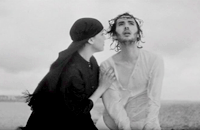There is an understatedly crystalline moment in Le Lit de la vierge (The Virgin’s Bed) when the scarlet woman, Marie Magdalène (Zouzou), having encountered the fragile and aimless Jesus (Pierre Clémenti) for the first time, cryptically explains that the men of the village pay for her company through the archaic currency of stones – and along the way, has amassed a collection that seemingly serves no other purpose than to have the potential having things to throw. The allusion to the casting of stones proves particularly incisive, not only within the loose, Biblical allegory of Philippe Garrel’s reconfigured tale of a dislocated, modern-day prophet who crosses paths with (and shows compassion towards) an adulterous woman, but also within the contemporaneity of the widespread social unrest that had defined the political and moral climate of May 68 – a turbulent, yet profoundly transformative era when emboldened, young radicals like Garrel who saw film as an integral instrument of protest were galvanized into direct social action, hurling rocks (as well as more incendiary objects) at riot police during the infamous Night of the Barricades (a personal watershed that Garrel would also recreate in Regular Lovers).
Filmed in the smoldered ashes of the failed social revolution as Garrel and a community of young artists from Zanzibar film (a film collective of like minded, radicalized artists financed by heiress Sylvina Boissonnas) abandoned the emblematic barricades of domestic protest and retreated to Africa to transfigure their ideological disappointment into subsumed cultural action through the creation of an intrinsically personal, revolutionary cinema, Le Lit de la vierge is, in a sense, the reconstitution of a fevered, post-traumatic creative manifesto – an impassioned, reflexive apologia composed in the fog of a drug-fueled delirium that not only reflected a not yet resigned sentiment of implicit denial over the failure of the revolution, but also served to reinforce the counter-culture generation’s delusive posture as alienated and discarded messianic ideologues who, nevertheless, continue to hold the keys to an ever-receding utopian paradise. In presenting an idiosyncratically distorted embodiment (or perhaps, resurrection) of fringe society through a sensitive, misunderstood, outcast savior plagued by self-doubt and dispirited by a pervasive sense of impotence against the weight of human suffering, Garrel illustrates, not only the profound loneliness and alienation caused by a singularity of vision (a recurring idealized representation of the May 68 generation as well-intentioned holy innocents that seeks kinship not only with the abstracted heroes of Carl Theodor Dreyer’s cinema – most notably, The Passion of Joan of Arc and Ordet – but also posits their intrinsic state of immanence, as revealed through their allusive alter-ego’s consuming empathy for the oppressed and the marginalized (an altruistic desire for connectedness that is reflected in Jesus’ despair over the seemingly anachronistic sight of bohemians being harassed by authorities within the sanctity of their own commune-like cavern dwellings).
But more intriguingly, Garrel’s fusion of iconic cultural history and allegorical social commentary also provides the prescient framework for what would become the inevitable mythologization of the events of May 68, where personal memory has been tinted by the idealized nostalgia of unrealized history, and irreparably altered by the intoxicated haze of (trans)formative years lived under the influence – creating an illusive (and delusive) romanticism borne of a need to reconcile a generation’s spiritual desolation with a sense of irrecoverable enlightenment that has been obscured (if not extinguished) by its own reclusive, escapist, and self-destructive behavior. It is, therefore, perhaps not surprising that the seemingly irreverent, Freudian casting of Zouzou in the dual role of the Virgin Mary and Marie Magdalène alludes to a duality of human nature that filmmaker Jean Eustache would subsequently explore in The Mother and the Whore, a film that also chronicles a moral self-destruction in the aftermath of the failed revolution. It is this perverted romanticization of incorruptible idealism and integrality of vision that is inevitably captured in the film’s final image of Jesus marching out to sea that, like the indelible image of the wide-eyed innocent child of Le Révélateur, becomes a symbolic act of willful resistance against the raging tide – a gesture, not of benevolent self-sacrifice, but a staged, empty spectacle of quixotic defiance.
© Acquarello 2007. All rights reserved.
